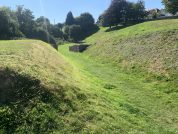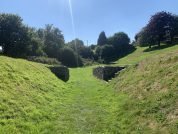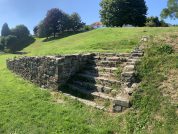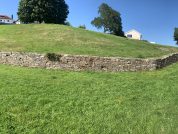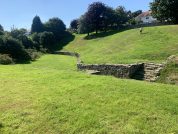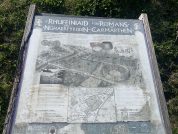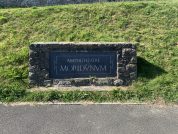Carmarthen (Moridunum) Roman Amphitheatre
Amphitheatre
The Moridunum Amphitheatre is possibly the furthest west in the roman world and is one of only seven surviving examples in the UK. It has the only above-ground Roman remains in the town, and was excavated in 1968. The ‘Cavea’ or seating area itself is 46 by 27 meters and is quite large when considering the size of the town it served. The circumference of the cavea seating area is 92 by 67 meters. It had stone walls and wooden seating and was much larger than would be expected for the size of the town.
At 150 m outside the presumed position of the E gate lies a large oval depression partly cut into a hillside. Excavation in 1968 disclosed the site of an amphitheater; the arena floor was covered with up to 2 m of silt. It was constructed by cutting into the hill and using the excavated soil to create the S bank of the cavea. The arena is 46 by 27 m, the circumference of the cavea ca. 92 x 67 m. The arena wall was nearly 2 m thick and built in the 2d c. Seating, however, was in timber with elaborate sub-frames to maintain the units in position on the hillside. The site of a bath house is also known on the Parade on the SE edge of the town. Finds are housed in the local museum.
The amphitheatre would probably have been used for everything from roman games, including gladiatorial contests, beast hunts and public executions, to military and civic parades and religious holidays and events. The amphitheatre would have been used by the roman inhabitants of the town itself, but also by the local native ‘Demetae’ tribe.
Roman artefacts from various excavations in Carmarthen can be found in the Carmarthenshire County Museum at Abergwili.
Sites near Carmarthen (Moridunum) Roman Amphitheatre
- Carmarthen (Moridunum) Vicus (0 km)
British Civita and Vicus - Carmarthen (Moridunum) Roman Fort (1 km)
Flavian Auxiliary Fort (AD 69–96) - Ffordd Fleming (16 km)
Roman Road - Cwmbrwyn Villa (19 km)
Villa - Dynevor Park Roman Fort (20 km)
Auxiliary Fort, Milestone, Temple Or Shrine and Vexillation Fort - Graig Fawr, Pontardulais (24 km)
Iron Age Hillfort - Tavernspite (25 km)
- Loughor (Letocetum) Roman Fort (27 km)
Flavian Auxiliary Fort (AD 69–96) - Tor-Gro (27 km)
Iron Age Hillfort - Pen-y-gaer, Pen-clawdd (28 km)
Iron Age Hillfort
